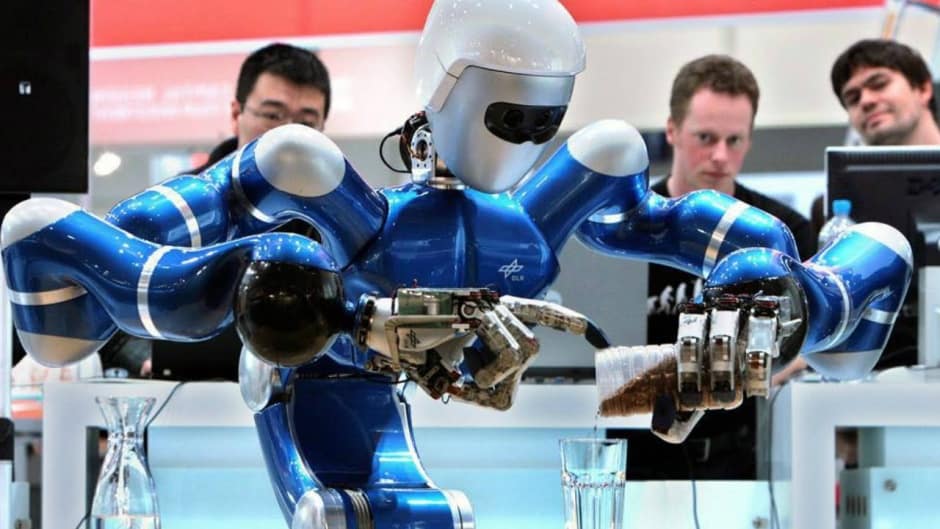
Barb the builder whistled on her way to work today. Her new exoskeleton suit has arrived and her back will be saved from lifting and laying bricks to build houses. But the happy mood took a nose-dive when she read about Hadrian X in the newspaper. It’s a new bricklaying robot that can lay 1,000 bricks an hour. It could build a house in 2 days that would take Barb and her team 6 weeks. ‘How can we compete with that’, she thought.
And Barb is not the only one who should be worried about robots taking her job. There has been a rapid upsurge in the number of robotic applications planned to replace human workers. Robots have been operating in factories since the 1950s but now they have moved outside into the service industry to serve food and drinks, to make burgers and pizzas faster than any human, to clean up and to take over transport with autonomous cars, trucks and busses. The mining industry is being transformed with robotics as are agriculture and delivery services. And this is just the beginning.

Reports abound about AI and robotics creating mass unemployment within a couple of decades. One of the earliest studies by Frey and Osborne (2013), forecast that 47% of all jobs in the USA could be computerised within twenty years. Predictions were based on criteria including repetitiveness and social interaction. Deloitte (2014) followed with studies in Britain, Switzerland and the Netherlands showing similar results. And more recently the Banks of America, UK and Italy have expressed grave concerns.
Is there a solution? No, but there are a number of suggestions. The Dutch report Mastering the Robot. The Future of Work in the Second Machine Age suggests an inclusive robotisation, with the core concepts of complementarity between human and robot skills and capabilities and, ownership of work. McKinsey & Company, suggest that we should rid ourselves of the concept of ‘occupations’ and instead utilise the concept of ‘work activities’. Robots may be used to replace or assist specified portions of a job rather than replacing or assisting an overall trade or occupation. They argue for a five-factor approach to predicting the automation of particular activities. Among these are the benefits of automation and the cost of workers who might otherwise perform the activity. This leads to a conclusion of only 5% displacement of workers. However, it does not take into account the plummeting costs of robotics and the accelerating number of tasks that can be performed.

Bill Gates has suggested that companies pay tax for a robot replacing a human. This would then be used in some way to compensate redundant workers. While tax sounds like a good idea it is not an ideal solution and is fraught with difficulties such as defining a robot and how many jobs it actually displaces. For example, it may be a new automated robot system that never had human workers like the Ocado supermarket that uses a swarm of co-operating robots for picking, packing and sorting groceries. And there are serious concerns that a robot tax could slow down this sort of innovation and possibly create more unemployment over the short term.
Providing a universal basic income (UBI) is another widely heralded suggestion. This takes a number of forms such as giving everyone the same amount and then taking some away for every dollar earned. This has difficulties as well. Who will set the basic amount and can it be guaranteed when new governments come into power? And where will the money come from? With significantly fewer people being employed we will need new economic models. We need to think about different possible scenarios and the likely impact they could have on our basic human rights and dignity. What kinds of inequality could emerge with a new technocratic elite? Will it aggravate gender, age and ethnic biases?
We need to decide what kinds of responsibilities we as a society will allow companies to delegate to a robot or AI
A recent head-in-the-sand vote at the European Parliament went against both robot tax and UBI without offering any alternative or promise to investigate the issues further. Other countries are less forward in their deliberations. Yet this is an urgent matter as the potential for a robot revolution in all areas of the workplace unfolds over the next decade.
Whether or not mass unemployment is immediately on the cards, we need to decide what kinds of responsibilities we as a society will allow companies to delegate to a robot or AI. We currently have no policies in place. Society needs to be better informed and play a larger role in decisions about the kind of good life we want to have and how robots fit into this picture. We need to shape a future with robots worth wanting.
By Prof Noel Sharkey (co-founder and chair of the Foundation of Responsible Robotics - FRR) and Dr Aimee van Wynsberghe (co-founder and President of FRR)











Arriva makes £300m tri-mode train order with Hitachi Rail
This development shows up the lack of a comprehensive nationwide network of electrified lines for passenger services and freight The glacial speed of...